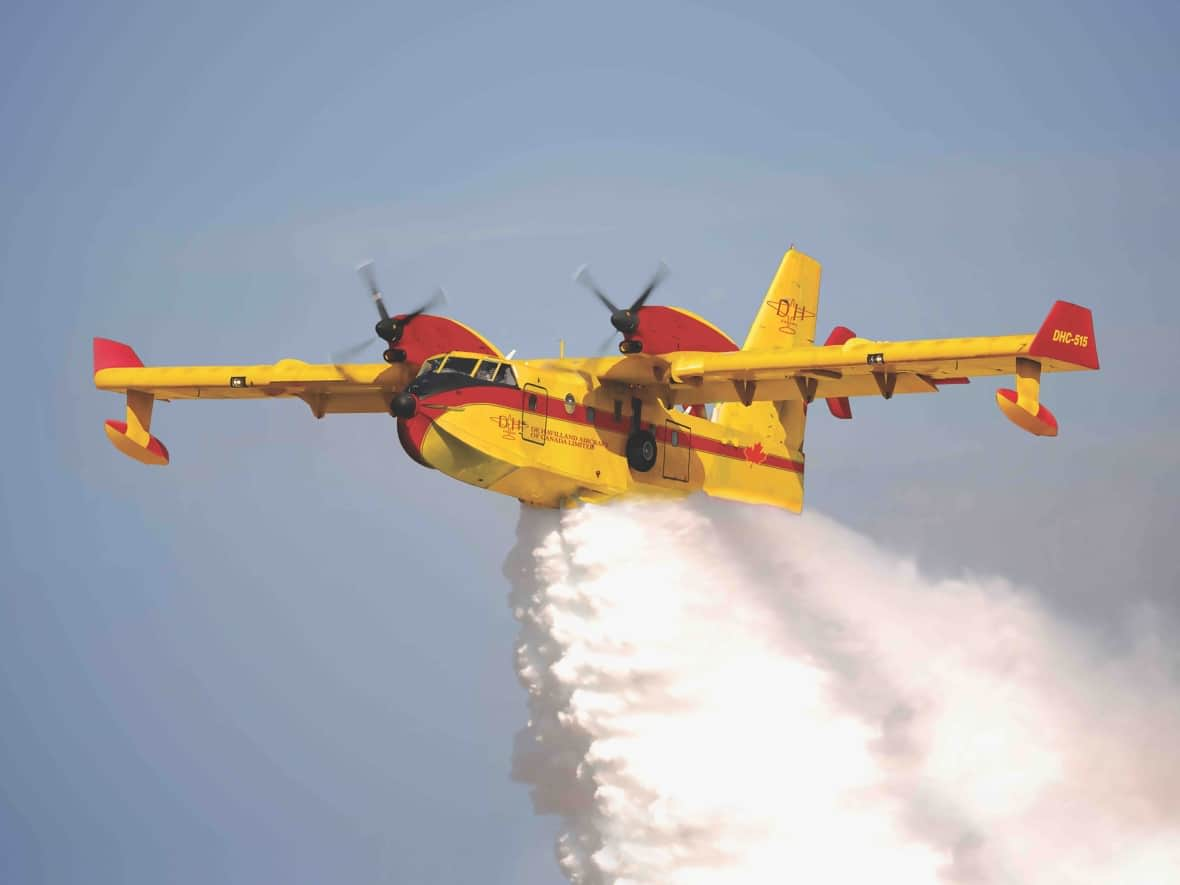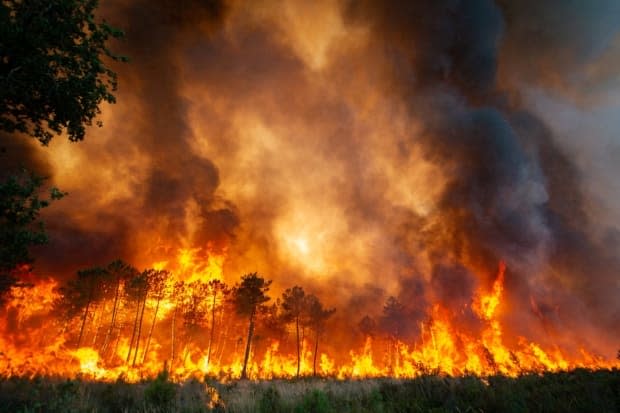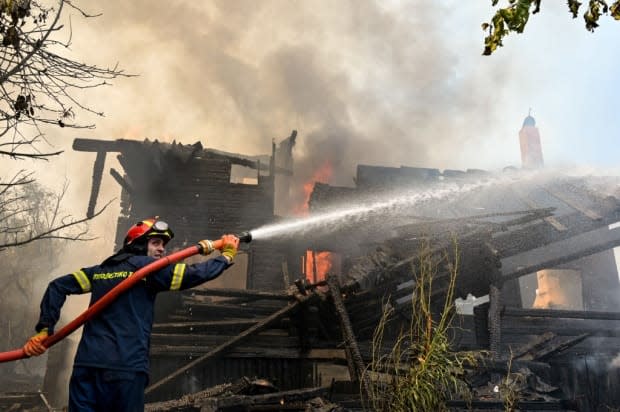How an aging fleet of Canadairs is keeping Europe's wildfires at bay

When French President Emmanuel Macron faced reporters after the "fire of the century" earlier this month forced the evacuation of thousands in the southwestern Gironde region, one phrase above all dominated the next day's headlines.
"Yes, we need more Canadairs."
The amphibious, Canadian-made water-bombing plane has set the gold standard for aerial firefighting for decades. But despite its reputation as a "proven tool" among fire experts, low demand kept the plane out of production for nearly a decade.
Now, amid expanding wildfire seasons made worse by climate change, countries like France are lining up to replace their aging fleets after Canadair manufacturer De Havilland announced it would restart production with an updated design called the DHC-515.
Some, though, worry the 22 planes destined for Europe by the end of the decade may be too little, too late.
Canadian innovation
First produced in the 1960s, the original Canadair CL-215 firefighting plane was designed for fighting vast fires in the Canadian wilderness.
Its unique amphibious design and low-speed control allowed it to navigate narrow canyons at low altitude, scooping thousands of litres of water directly from lakes and oceans in seconds.

In the decades since, the planes became iconic for their near-unbreakable design. Of the original 220 planes built before 1995, nearly 170 are still in use, according to Neil Sweeney, De Havilland Canada's vice-president of corporate affairs.
But an updated plane very nearly didn't make it to production. Rights to the Canadair design have bounced between companies over the past decade.
Plans to begin production on the DHC-515 in 2020 stalled when the pandemic "refocused … priorities away from longer-range thinking" and dried up demand from governments, according to Sweeney.
"It does take an awful lot to build a production line, and in order to do so, you need orders from prospective customers," he said.
Now, after nearly a decade on hold, Sweeney said, "the EU has stepped up to the plate."
Aging fleets
As many European governments switched focus from pandemic to recovery this spring, they faced down an imminent wildfire season that many expected to be historic.
Climate change is turning the continent into a hotter, drier place. Scientists say the drought still ravaging Europe is unmatched in the last 500 years. As a result, wildfires are becoming larger and more common in countries, like Germany, with limited experience of them.
WATCH | Europe heating up faster than rest of the world, says climate expert:
Last year's wildfires in Greece were nearly six times larger than any other time in the past decade. But the Hellenic Air Force has been tackling the fires with a fleet of CL-215s that have been in service since the 1970s.
"Many of the parts are very hard to find, so we can have long delays in repairing certain damage," Lieut.-Col. Antonios Vourvoulis told the Greek daily I Kathimerini in 2018. "It is a daily struggle."
The sorry state of France's 12 CL-415s was partly blamed for the scale of devastation wrought by historic wildfires in Bordeaux, which forced the evacuation of thousands.
But France is still better off than those countries with no water-bombers at all — such as the Czech Republic, which needed to borrow planes from Italy to battle a massive blaze on its border with Germany this summer.
'Voluntary solidarity'
Loans of this kind are acts of "voluntary solidarity," according to Balazs Ujvari, the European Commission's spokesperson for Humanitarian Aid and Crisis Management.
But as worsening wildfires put a strain on resources, leaders across the continent are looking for more permanent solutions.
"This is something that will happen more and more often, and it's very clear that member states won't always be able to handle these things on their own," Ujvari said.

That's one reason the European Union is planning to grow its own reserve of firefighting aircraft. Since 2019, a program called RescEU has directed 13 firefighting aircraft, including new-model Canadairs, to where they are needed most.
This year, six were sent to France, alongside more than 400 personnel and 100 vehicles — the commission's biggest operation yet.
For now, those resources are still being borrowed from other member states. But "by the end of the decade, the goal is to double these capacities and to purchase … aircraft using EU funds," Ujvari said.
NATO has also stepped up to help. Through the NATO Support and Procurement Agency (NSPA), member states can use the alliance as a go-between to negotiate contracts for firefighting resources from allies and the private sector. This summer, the alliance arranged for a record 40 aircraft to support Greece, including 11 firefighting planes.
Stacey Cummings, NSPA's general manager, said she anticipates competition for those resources to increase as the impacts of climate change worsen.
"I can only see there being a higher demand for a limited capacity going forward," she said.
'Better not to need them'
As countries compete for a shrinking stock of planes, news earlier this year that De Havilland would gear up its assembly line in Calgary was greeted with relief.
"When I saw the news some weeks ago that Canadair is coming back to the market, it felt quite good," said Alexander Held, a wildfire expert with the European Forest Institute. "The Canadair is a proven tool. It was actually sad to see that they stopped production."
The restart was made possible by a letter of intent signed in March, which would see 22 planes delivered to European governments by 2029.
But while new Canadairs are badly needed, fire experts like Held stress they are only part of the solution — and one that may not arrive fast enough.
"It is just showing a long-term failed policy of fire management," Held said. "With all the joy that this aircraft is coming back, still we have to remember, it would be better not to need them."

Held said alongside the millions of euros spent on water-bombing planes, countries should budget more for wildfire prevention programs, like supporting land managers and shepherds to keep fuel in check, and offering training in techniques, like dry firefighting, that don't require heavy water use.
"Everyone knows you should invest in other parts of fire management. No one ever does it," Held said. "It's dealing with the symptoms, and not with the causes."
De Havilland's Sweeney says the new planes will add power to Europe's firefighting fleet for decades to come, promising the DHC-515 will be just as indestructible as the planes that came before.
"You might argue that from a business case, [making long-lasting planes] makes less sense," he said. "But it's really a point of pride for our company and our country."

 Yahoo Movies
Yahoo Movies 
